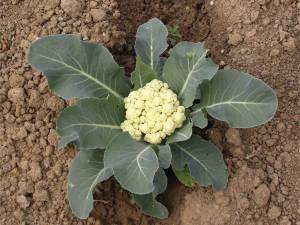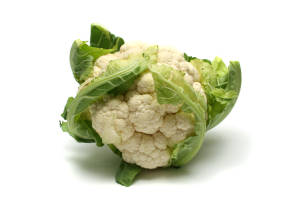Cauliflower may not be the most exciting of all vegetables, but it is what one might call functional. It is filling and healthy and can be tarted up (and made significantly less healthy) with cheese. People growing cauliflower at home for the first time may be excited to find that its taste is much sweeter when home grown compared to the blandness in supermarket bought varieties.
Cauliflower is a cold climate vegetable that doesn’t do very well in frosty conditions. Therefore its important to choose the right variety for your area of the world. The easiest way to find out is to speak to your local nursery or organic store and ask what does best in your region. Cauliflower has been significantly genetically adapted over the centuries to be more hardy but it remains a reasonably difficult vegetable to grow due to its climate and day length requirements. Cauliflower is typically classified by its maturation time – early, middle and late.
Planting Cauliflower
Generally, cauliflower is sown in summer and autumn, or later if winter is especially mild in your region. Some people choose a number of varieties from the early, middle and late maturation time in order to harvest for a longer time.

Cauliflower seeds should be sown in trays or punnets then transplanted to pots once they are large enough to pick up. You can use a seedbed too – sow half an inch (1cm) deep.
Its time to transplant to the ground once the cauliflowers are about 4 inches (10cm) tall. The garden bed should be large enough to accommodate spacing of 2 feet (60cm) between rows and plants, so that the end result is a grid of plants. If you are growing smaller or mini cauliflowers they can be planted much closer, but retain the 2 feet between rows.
Growing Cauliflower
Cauliflowers need exposure to sunlight but can’t be too exposed. The most vital part of growing cauliflower is the soil. It needs to be deep, rich, moist and free-draining with a pH of 6.5 to 7.5. To retain moisture in the soil, cover with an inch of mulch and provide a good deep soaking once per week.
Cauliflower that is grown naturally may have more of a yellow tint than we are used to seeing in the supermarket. To combat this, gardeners can shade cauliflower for a few weeks before harvesting in order to blanch them. If a tent or tarpaulin is not feasible, you can bend the leaves over the edible part of the plant and tie them together. Be sure to check for pests every now and then if using this technique.
Fertilize once per month, preferably with a fish-based fertilizer. As they grow, you may need to earth up around the stems to keep them stable.
Harvesting Cauliflower
Expect growth time to be 3-6 months. Its time to harvest if they start to go brown or if the florets start to separate. Harvest in the morning.
They can be stored for around 3 weeks in a cool environment if they are uprooted, leaves and all. They last about a week in the refrigerator. Otherwise, blanch for 3 minutes and freeze florets in bags.
Threats to Cauliflower
Bugs, including caterpillars and aphids, are the biggest annoyance. Be sure to check under the leaves regularly.

